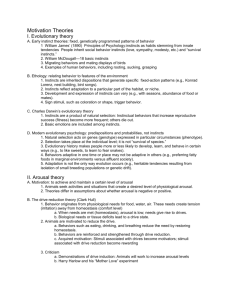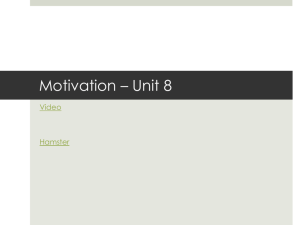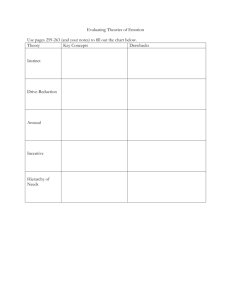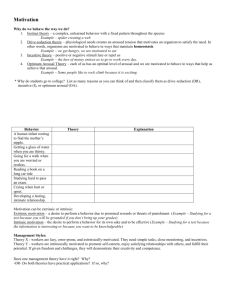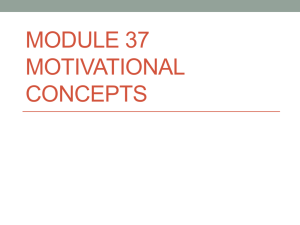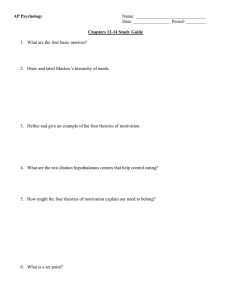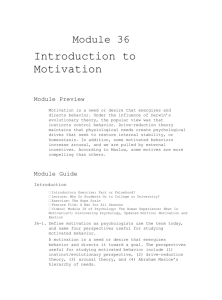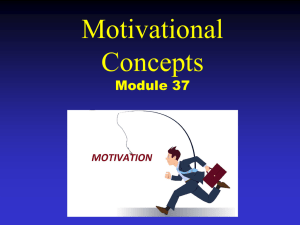Motivation Theories Name: I. theory A. Early instinct theories: fixed
advertisement
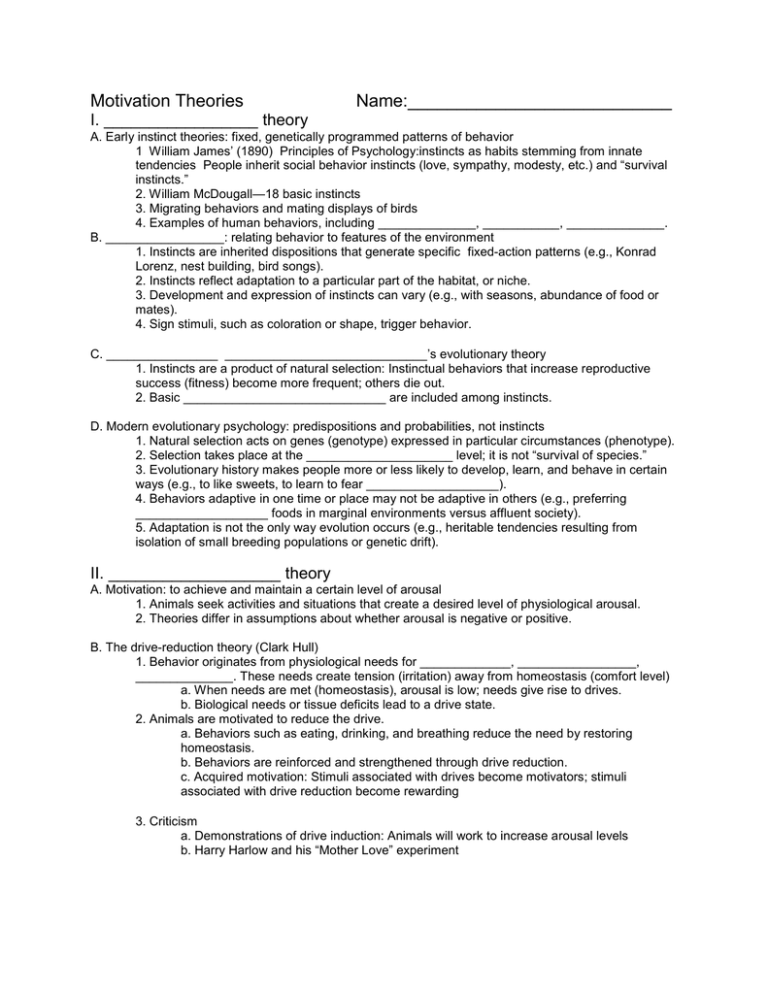
Motivation Theories Name:___________________________ I. _________________ theory A. Early instinct theories: fixed, genetically programmed patterns of behavior 1 William James’ (1890) Principles of Psychology:instincts as habits stemming from innate tendencies People inherit social behavior instincts (love, sympathy, modesty, etc.) and “survival instincts.” 2. William McDougall—18 basic instincts 3. Migrating behaviors and mating displays of birds 4. Examples of human behaviors, including ______________, ___________, ______________. B. _________________: relating behavior to features of the environment 1. Instincts are inherited dispositions that generate specific fixed-action patterns (e.g., Konrad Lorenz, nest building, bird songs). 2. Instincts reflect adaptation to a particular part of the habitat, or niche. 3. Development and expression of instincts can vary (e.g., with seasons, abundance of food or mates). 4. Sign stimuli, such as coloration or shape, trigger behavior. C. ________________ _____________________________’s evolutionary theory 1. Instincts are a product of natural selection: Instinctual behaviors that increase reproductive success (fitness) become more frequent; others die out. 2. Basic _____________________________ are included among instincts. D. Modern evolutionary psychology: predispositions and probabilities, not instincts 1. Natural selection acts on genes (genotype) expressed in particular circumstances (phenotype). 2. Selection takes place at the _____________________ level; it is not “survival of species.” 3. Evolutionary history makes people more or less likely to develop, learn, and behave in certain ways (e.g., to like sweets, to learn to fear ___________________). 4. Behaviors adaptive in one time or place may not be adaptive in others (e.g., preferring ___________________ foods in marginal environments versus affluent society). 5. Adaptation is not the only way evolution occurs (e.g., heritable tendencies resulting from isolation of small breeding populations or genetic drift). II. ___________________ theory A. Motivation: to achieve and maintain a certain level of arousal 1. Animals seek activities and situations that create a desired level of physiological arousal. 2. Theories differ in assumptions about whether arousal is negative or positive. B. The drive-reduction theory (Clark Hull) 1. Behavior originates from physiological needs for _____________, _________________, ______________. These needs create tension (irritation) away from homeostasis (comfort level) a. When needs are met (homeostasis), arousal is low; needs give rise to drives. b. Biological needs or tissue deficits lead to a drive state. 2. Animals are motivated to reduce the drive. a. Behaviors such as eating, drinking, and breathing reduce the need by restoring homeostasis. b. Behaviors are reinforced and strengthened through drive reduction. c. Acquired motivation: Stimuli associated with drives become motivators; stimuli associated with drive reduction become rewarding 3. Criticism a. Demonstrations of drive induction: Animals will work to increase arousal levels b. Harry Harlow and his “Mother Love” experiment C. _________________________ ______________________________ theory 1. Some nonzero level of arousal is optimal. a. Arousal below optimal level motivates behavior to increase arousal. b. Arousal above optimal level motivates behavior to decrease arousal. 2. Individual differences: People vary in the degree to which they seek lower or higher levels of arousal. Zuckerman (1984, 2007): sensation seeking as an aspect OF __________________, related to risky behavior 3. Yerkes-Dodson law relates arousal level to task performance. a. Arousal level for optimal performance depends on task difficulty. b. Optimal level of arousal is lower for harder tasks. c. High arousal can improve performance on easy tasks and impair performance on difficult tasks. III. Incentive theory: Motivation is produced by need for ___________ attainment. A. Need for goal attainment or achievement may be either intrinsic or extrinsic. 1. __________________ motivation is based on internal need for achievement and internal reinforcers, such as positive feelings of accomplishment. 2. Extrinsic motivation is based on external, often tangible, reinforcers. B. Effect of external reward on intrinsic motivation 1. Providing an extrinsic reward for intrinsically motivated behavior can decrease interest in the task (overjustification effect). 2. Extrinsic reward can decrease, increase, or have no effect on intrinsic motivation depending on many factors, e.g., whether performance standards are vague or clear IV. __________________ __________________ theory: Motivation for thoughts to be consistent with behavior A. Cognitive dissonance theory (Festinger): Beliefs contrary to some behavior produce tension or dissonance and, so, motivation to change beliefs or behavior to reduce dissonance. B. Self-perception theory (Bem): An individual perceives his or her own behavior and forms beliefs and attitudes that are consistent with it. V. Humanistic theory A. Maslow’s hierarchy of needs 1.Needs are ordered from basic survival to psychological needs: physiological, safety, belongingness, esteem, self-actualization, and transcendence. 2. Each successive level of the hierarchy is addressed only after the preceding level’s needs have been met (concept of prepotency). 3. Criticism: elitist, ordering of hierarchy, e.g., political or religious fasting B. Csikszentmihalyi’s flow 1. Deep, authentic involvement in meaningful activities 2. Requires skilled control over instinctive drives PESSIMIST OPTIMIST_______________________
